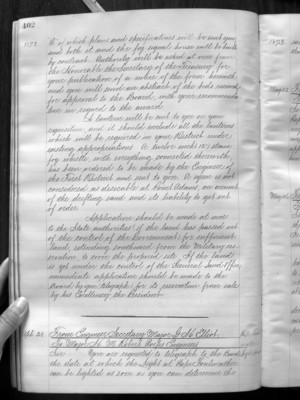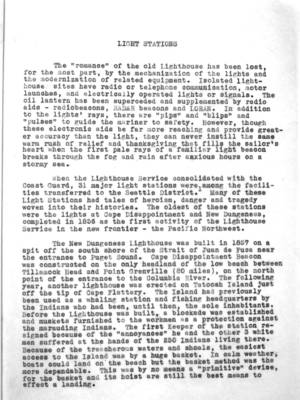Pages That Mention lantern
1870-73 Lighthouse Board Annual Reports
48
1873
"C" of which plans and specifications will be sent you, and both it and the fog - signal house will be built by contract. Authority will be asked at once from the Honorable the Secretary of the Treasury for your publication of a notice of the form herewith and you will send and abstract of the bids received for approval to the Board, with your recommendation in regard to the award. A lantern will be sent to you on your requisition, and it should include all the lanterns which will be required in your District under existing appropriations. A twelve inch (12") steam for whistle, with everything connected therewith has been ordered to be made by the Engineer of the First District and sent to you. A syren is not considered as desirable at Point Adams, on account of the drifting sand and its liability to get out of order. Application should be made at once to the State authorities (if the land has passed out of the control of the Government) for sufficient land, extending southward from the Military reservation, to cover the proposed site. If the land is yet under the control of the General Land Office, immediate application should be made to the Board by you (telegraph) for its reservation from sale by his Excellency, the President.
_________________________________________
Apl. 28. Cape Foulweather Lighthouse
From Engineer Secretary Major G. H. Elliot. To Major H. M. Robert, Corps Engineers.
Sir: You are requested to telegraph to the Board the date at which the Light at Cape Foulweather can be lighted as soon as you can determine the
49
1873.
"C" of which plans and specifications will be sent you and both it and the fog-signal house will be built by contract. Authority will be asked at once from the Honorable the Secretary of the Treasury for your publication of a notice of the form herewith and you will send an abstract of the bids received for approval to the Board, with your recommendation in regard to the award.
A lantern will be sent to you on your requisition, and it should include all the lanterns which will be required in your District under existing appropriations. A twelve inch (12") steam fog-whistle, with everything connected therewith, has been ordered to be made by the Engineer of the First District and sent to you. A ??? is not considered as desirable at Point Adams, on account of the drifting sand and its liability to get out of order.
Application should be made at once to the State authorities (if the land has passed out of the control of the Government) for sufficient land, extending southward from the Military reservation, to cover the proposed site. If the land is yet under the control of the General Land Office, immediate application should be made to the Board by you (telegraph) for its reservation from sale by his Excellency, the President.
_____________________________________________________
Apl. 28. From Engineer Secretary Major G. H. Elliot. To Major H. M. Robert. Corps Engineers.
Sir: You are requested to telegraph to the Board the date at which the Light at Cape Foulweather can be lighted as soon as you can determine the
Coast Guard District narrative histories 1945
20
LIGHT STATIONS
The "romance" of the old Lighthouse has been lost, for the most part, by the mechanization of the lights and the modernization of related equipment. Isolated lighthouse sites have radio or telephone communication, motor launches, and electrically operated lights or signals. The oil lantern has been superceded and supplemented by radio aids - raidobeacons, RADAR beacons and LORAN. In addition to the lights' rays, there are "pips" and "blips" and "pulses" to guide the mariner to safety. However, though these electronic aids be far more reaching and provide greater accuracy than the light, they can never instill the same warm rush of relief and thanksgiving that fills the sailor's heart when the first pale rays of a familiar light beacon breaks through the fog and rain after anxious hours on a stormy sea.
When the Lighthouse Service consolidated with the Coast Guard, 31 major light stations were among the facilities transferred to the Seattle District.¹ Many of these Light Stations had tales of heroism, danger and tragedy woven into their histories. The oldest of these stations were the lights at Cape Disappointment and New Dungeness, completed in 1856 as the first activity of the Lighthouse Service in the new frontier - the Pacific Northwest.
The New Dungeness Lighthouse was built in 1857 on a spit off the south shore of the Strait of Juan de Fuca near the entrance to Puget Sound. Cape Disappointment Beacon was constructed on the only headland of the low beach between Tillamook Head and Point Grenville (80 miles), on the north point of the entrance to the Columbia River. The following year, another lighthouse was erected on Tatoosh Island just off the tip of Cape Flattery. The Island had previously been used as a whaling station and fishing headquarters by the Indians who had been, until then, the sole inhabitants. Before the Lighthouse was built, a blockade was established and muskets furnished to the workmen as protection against marauding Indians. The first Keeper of the station resigned because of the "annoyances" he and the other 3 white men suffered at the hands of the 250 Indians living there. Because of the treacherous waters and shoals, the easiest access to the Island was by a huge basket. In calm weather, boats could land on the beach but the basket method was the more dependable. This was by no means a "primitive" devise, for the basket and its hoist are still the best means to effect a landing.
21
In the quite rapid succession, Umpqua River, Willapa Bay, Smith Island, Ediz Hook, Cape Arago, Cape Blanco, Point No Point, Point Wilson, and Yaquina Bay Lighthouses were built. In 1879, construction began on the Tillamook Rock Beacon.
Tillamook Rock Lighthouse was one of the most famous as well as one of the most exposed stations in the Lighthouse Service, set on a great precipitous rock lying a mile offshore from Tillamook Head on the Oregon Coast. A dark cloud of ill omen shadowed the station as, in the landing of the construction party, the superintendent was swept by a great wave into the sea and drowned. Almost insurmountable obstacles faced the engineers, for the entire top of the rock mass had to be blasted level to provide space for the lighthouse and its accompanying structures. Heavy seas continually washed over the Rock carrying away half finished foundations, equipment and endangering the lives of the entire work party. Although the light stood 133 feet above the water, on many occasions tremendous waves swept completely over the station carrying large fragments of rock which caused considerable damage to the station. On one such occasion, a rock weighting 135 pounds was hurled through the roof of the building and into the quarters below, causing extensive damage. Another time, the sea tossed a boulder through the lantern, extinguished the light and flooded the dwelling below.
West Point, built in 1881, Alki Point and Brown Point, built in 1887 and Destruction Island, built in 1891, were the next light stations to be erected. Here again, at Destruction Island, treacherous seas made landings difficult except in calm weather, so the "basket" and boom were again called upon for safe landings on the station. 14 other lighthouses were established in the Seattle District, the last being the Lim Kiln structure in 1914. Strangely enough, the Lime Kiln Lighthouse was the last light station in the District operating an oil lantern. An attempt was made to electrify the light by extending commercial power to the Station but the Power Company was unable to furnish sufficient current; in the same regard, poles had to be set in a solid rock and the cost and labor for this were almost prohibitive. A request was made for Headquarters' approval to install a power plant at the unit but this was not commensurate with Headquarters' policy so the light remained an incandescent oil vapor type. This type, familiarly known as i.o.v., gave good service although its range could not match that of the newer electric light. The old i.o.v. light came in two sizes and was approximately equivalent
-2-
55
miles from Mason City to the Canadian border. A question arose as to whether or not Roosevelt Lake constituted part of "the navigable waters of the United States" as interpreted by the laws. In March, 1944, the Law Officer advised that Roosevelt Lake was navigable and, together with the Columbia River which flows into it and gives rise to it, furnished a water way for foreign commerce. With this fact established, it became necessary to establish aids to navigation along the lengths of this lake. At that time, there was very little traffic on Roosevelt Reservoir but it was the opinion of local marine interests that the traffic was bound to increase not only commercially but in pleasure craft following the war. Numerous hazards existed that made travel especially dangers under the conditions as they then existed. In a meeting between the Superintendent of the Coulee Dam and representatives of the District Coast Guard Officer, location were proposed for spar buoys to be anchored in the lake and provide the shortest run from Grand Coulee Dam to Kettle Falls, Washington. These locations were consistent with assumed limitations of 20 feet of water at buoy locations with a maximum reservoir drawdown at elevation 1208 and a minimum distance between the buoys 1/2 mile; the normal elevation of the reservoir when full is 1290. An investigation made by the Aids to Navigation Officer determined that 27 lights and 10 reflectors would suffice to mark the lake. The Bureau of Reclamation was in favor of the establishment of 51 buoys but the District Coast Guard Officer felt that buoys would be impracticable for several reasons. Due to the lowering of the water to different levels which would cause different shoal areas to appear and changes would have to be made in the buoys to keep the channel safely and effectively marked. Furthermore, the mountainous land area which formed the bottom of the lake together with the deep water, rendered use of buoys inadvisable; for in many places the buoys would be moored in over 200 feet of water which would require large buoys and, consequently, the services of a buoy tender. Unlighted buoys were not considered, for, as such, they would be inadequate. For these reasons then the Aids to Navigation Officer determined that the 27 lights and 10 reflectors would be adequate. These lighted aids would consist of a battery box on a concrete foundation with a 200mm lantern with a focal plane of 12 feet. Aids were to display a white light of 90 candlepower, flashing either every 4 seconds, 6 seconds or 10 seconds, and were to be serviced by the Seattle Operating Base twice a year with half of the batter cells being relieved at a time. The Bureau of Reclamation extended the use of one of its boats to be used in establishing these aids and in the servicing of them.
-35-




